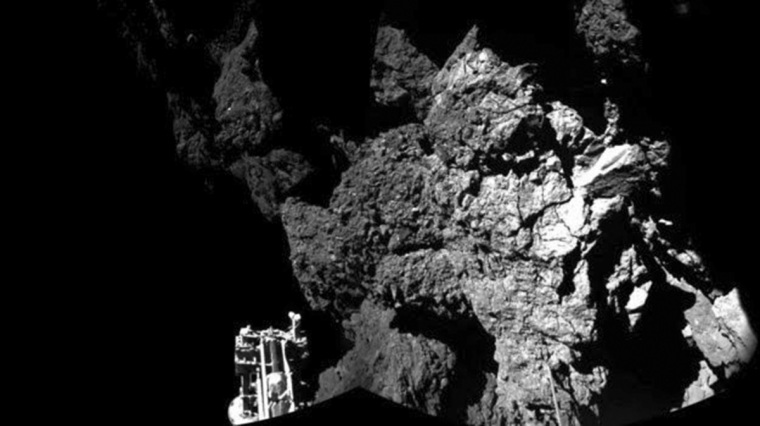Rosetta Philae Landing Probe Video, Latest News: European Probe Lands On Comet
"A big step for human civilization."
The head of the European Space Agency (ESA), Jean-Jacques Dordain, gushed out the words as he, other space scientists and the rest of mankind watched in awe on Wednesday as a European probe called Philae touched down on a speeding comet after a 10-year rendezvous.

After a seven-hour descent from its mothership Rosetta, the 220-pound Philae, which is the size of a washing machine, landed on Comet 67P/Churyumov-Gerasimenko, a 2.5-mile-wide ball of rock, ice and dust moving faster than 40,000 miles an hour.
The European lander bounced off the surface of the comet and into space twice before settling down at around 1730 GMT on Wednesday, according to the mission control center in Darmstadt, Germany, at 5:03 p.m. Thursday local time (11:03 a.m. Eastern time).
Both the Rosetta and Philae immediately beamed back images of the comet half a billion kilometers away from Earth.
The image provided by ESA above shows Philae on the comet's bleak, rocky surface.
"We're there, and Philae is talking to us!" said Stephan Ulamec, the manager for the lander. "We are on the comet."
The nations and organizations that collaborated on the $1.75-billion space mission cheered at the scientific milestone, the climax of a 10-year, four-billion-mile trip.
"How audacious!" said James L. Green, the director of NASA's planetary sciences division. "How exciting! How unbelievable to be able to dare to land on a comet."
It marked the first time that a man-made craft landed on a comet, not counting the NASA probe that hit comet Tempel-1. Human probes have earlier landed on the surface of the moon, Mars, Venus, Saturn's moon Titan, and two asteroids.
Before Philae's comet touchdown, the Rosetta became the first spacecraft to orbit a comet rather than just flying past to take pictures.
Philae's next mission, according to scientists, is to drill the surface of the comet in the hope of discovering how the planets – and life itself – evolved. The rock and ice that make up the comets are thought to preserve ancient organic molecules like a time capsule.
One of the questions that the mission will seek to answer is whether Earth's oceans are filled with melted comets.
Scientists believe that there was no water when bits of rocks came together to form planet Earth billions of years ago. Water had to come from somewhere else. Scientists say one possibility is that the early icy comets that slammed into Earth delivered water to the planet, thus forming our oceans. Comets are frozen debris that resulted from the formation of our solar system.
Scientists also hope that the European comet mission will offer significant clues on how the solar system came into being 4.5 billion years ago.
Moreover, scientists believe that the technology used in landing a man-made probe on a comet could be applied to future efforts to land similar probes on asteroids with the intent to mine them.
More universal mysteries are expected to be unravelled as Philae and its 10 instruments begin scientific explorations on Comet 67P/Churyumov-Gerasimenko. Solar panels will recharge the probe's batteries, allowing the mission to continue for months to come.
 Christians don't have to affirm transgenderism, but they can’t express that view at work: tribunal
Christians don't have to affirm transgenderism, but they can’t express that view at work: tribunal Archaeology discovery: Medieval Christian prayer beads found on Holy Island
Archaeology discovery: Medieval Christian prayer beads found on Holy Island Presbyterian Church in America votes to leave National Association of Evangelicals
Presbyterian Church in America votes to leave National Association of Evangelicals Over 50 killed in 'vile and satanic' attack at Nigerian church on Pentecost Sunday
Over 50 killed in 'vile and satanic' attack at Nigerian church on Pentecost Sunday Ukrainian Orthodox Church severs ties with Moscow over Patriarch Kirill's support for Putin's war
Ukrainian Orthodox Church severs ties with Moscow over Patriarch Kirill's support for Putin's war Islamic State kills 20 Nigerian Christians as revenge for US airstrike
Islamic State kills 20 Nigerian Christians as revenge for US airstrike Man who served 33 years in prison for murder leads inmates to Christ
Man who served 33 years in prison for murder leads inmates to Christ


 Nigerian student beaten to death, body burned over ‘blasphemous’ WhatsApp message
Nigerian student beaten to death, body burned over ‘blasphemous’ WhatsApp message 'A new low': World reacts after Hong Kong arrests 90-year-old Cardinal Joseph Zen
'A new low': World reacts after Hong Kong arrests 90-year-old Cardinal Joseph Zen Iran sentences Christian man to 10 years in prison for hosting house church worship gathering
Iran sentences Christian man to 10 years in prison for hosting house church worship gathering French Guyana: Pastor shot dead, church set on fire after meeting delegation of Evangelicals
French Guyana: Pastor shot dead, church set on fire after meeting delegation of Evangelicals ‘Talking Jesus’ report finds only 6% of UK adults identify as practicing Christians
‘Talking Jesus’ report finds only 6% of UK adults identify as practicing Christians Mission Eurasia ministry center blown up in Ukraine, hundreds of Bibles destroyed: 'God will provide'
Mission Eurasia ministry center blown up in Ukraine, hundreds of Bibles destroyed: 'God will provide' Church holds service for first time after ISIS desecrated it 8 years ago
Church holds service for first time after ISIS desecrated it 8 years ago Burger King apologizes for 'offensive campaign' using Jesus' words at the Last Supper
Burger King apologizes for 'offensive campaign' using Jesus' words at the Last Supper Uganda: Muslims abduct teacher, burn him inside mosque for praying in Christ’s name
Uganda: Muslims abduct teacher, burn him inside mosque for praying in Christ’s name